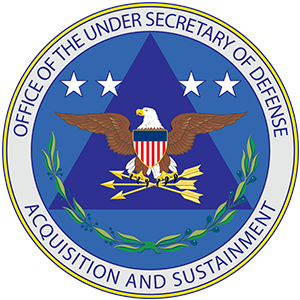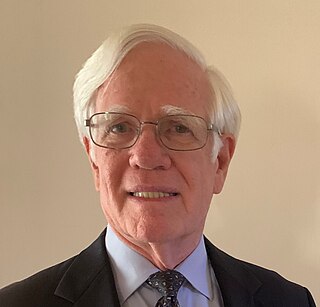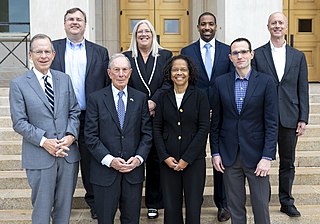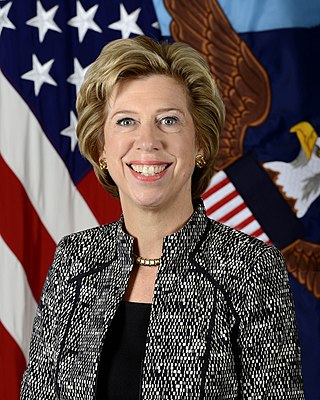Related Research Articles

The Defense Advanced Research Projects Agency (DARPA) is a research and development agency of the United States Department of Defense responsible for the development of emerging technologies for use by the military.
The Lockheed Martin Corporation is an American aerospace, arms, defense, information security, and technology corporation with worldwide interests. It was formed by the merger of Lockheed Corporation with Martin Marietta in March 1995. It is headquartered in North Bethesda, Maryland, in the Washington, D.C. area. As of January 2022, Lockheed Martin employs approximately 115,000 employees worldwide, including about 60,000 engineers and scientists.

The Defense Intelligence Agency (DIA) is an intelligence agency and combat support agency of the United States Department of Defense, specializing in defense and military intelligence.

The Office of the Secretary of Defense Identification Badge is a military badge issued to members of the United States armed forces who are permanently assigned to the Office of the Secretary of Defense (OSD) and its subordinate offices, and in addition, to some of the Defense Agencies and Department of Defense Field Activities.

Washington Headquarters Services (WHS) is a Department of Defense (DoD) Field Activity, created on October 1, 1977, to provide administrative and management support to multiple DoD components and military departments in the National Capital Region and beyond.
Counterintelligence Field Activity (CIFA) was a United States Department of Defense (DoD) agency whose size and budget were classified. The CIFA was created by a directive from the Secretary of Defense, then Donald Rumsfeld, on February 19, 2002. On August 8, 2008, it was announced that CIFA would be shut down. The Defense Intelligence Agency (DIA) absorbed most of the components and authorities of the CIFA into the Defense Counterintelligence and Human Intelligence Center, which was later consolidated into the Defense Clandestine Service.

The United States Department of Defense is an executive branch department of the federal government of the United States charged with coordinating and supervising all agencies and functions of the U.S. government directly related to national security and the United States Armed Forces. As of June 2022, the U.S. Department of Defense is the largest employer in the world, with over 1.34 million active-duty service members, including soldiers, marines, sailors, airmen, and guardians. DoD also maintains over 778,000 National Guard and reservists, and over 747,000 civilians bringing the total to over 2.87 million employees. Headquartered at the Pentagon in Arlington County, Virginia, just outside Washington, D.C., DoD's stated mission is to provide "the military forces needed to deter war and ensure our nation's security".

The Under Secretary of Defense for Acquisition and Sustainment, or USD(A&S), is the Principal Staff Assistant (PSA) and advisor to the Secretary of Defense for all matters relating to acquisition and sustainment in the Department of Defense. This includes the DoD Acquisition System; system design and development; production; logistics and distribution; installation maintenance, management, and resilience; military construction; procurement of goods and services; material readiness; maintenance; environment and energy resilience ; utilities; business management modernization; International Armaments Cooperation, Cooperative Acquisition and International Agreements, Promoting exportability of military components to allies and partners; nuclear, chemical and biological defense programs; and nuclear command, control, and communications.

The Under Secretary of Defense for Research and Engineering, abbreviated USD (R&E), is a senior official of the United States Department of Defense. The USD (R&E) is charged with the development and oversight of technology strategy for the DoD. The post has at various times had the titles Assistant Secretary of Defense for Research and Engineering, or Director of Defense Research and Engineering (DDR&E). The latter title has itself historically varied between the rank of under secretary and that of assistant secretary.

Adam Jay Harrison is an American defense industry entrepreneur, inventor, and advocate for military acquisition reform. He works as a startup founder and investor and is the John R. Boyd National Security Innovation Fellow at New York University, where he researches the efficacy of national innovation policies that capitalize on collaboration between the public and private sectors. In 2006 Harrison founded Mav6, a defense technology company recognized by Inc. magazine in 2011, 2012, and 2013 as one of the fastest growing privately held companies in America. From 2016 to 2017 he served as the inaugural director of the MD5 National Security Technology Accelerator, a human capital innovation program within the Office of the Secretary of Defense and part of the Defense Innovation Unit. And from 2018 to 2019 he was the Command Innovation Officer of the US Army Futures Command, where he designed and implemented the organization's efforts to collaborate with the civilian high-tech sector in the development of advanced, military-relevant capabilities.

Linton Wells II is an American public servant and educator who served a total of 51 years in government service. He served 26 years in the United States Navy as an officer, and then was appointed by the President of the United States as the Principal Deputy Assistant Secretary of Defense, serving through two administrations of both parties, both the Democrat Bill Clinton and the Republican George W. Bush. He wrote many books, articles, and white papers on matters of national security, including important texts related to the use of American military capabilities in global humanitarian operations. His expertise focused on the strategic impacts of technological change and on building resilience to natural and man-made disasters as issues of US national security. He shaped, over five decades of public service, current US Department of Defense directives that link policy and technology with public-private cooperation. His writings significantly altered U.S. and international approaches to civil-military engagement, US policy in global humanitarian assistance, and global public-private partnerships in disaster relief. He has also made fundamental contributions to technical areas that have defined network-enabled military capabilities and cyberspace operations. After retiring from public service, he continued to contribute to the international STAR-TIDES network that he had founded in 2007, a consortium of several thousand global nodes comprising agencies, organizations, institutions and individuals in 40+ countries that promote the free exchange of research results on global issues of human security. As of 2021 he is Executive Advisor to the Center for Resilient and Sustainable Communities (C-RASC) at George Mason University and chairs the Advisory Group of the C4I and Cyber Center there. C-RASC has been working with the People-Centered Internet (PCI) on ways to “put humanity at the center of the Internet” and support a variety of revitalization initiatives. He is on the board of PCI, and also the President and CEO of Global Resilience Strategies and Senior Advisor to Resilient Japan. He was listed by Fortune magazine in 2009 as one of the top 16 "Players of Tech".

The Defense Innovation Board is an independent advisory board set up in 2016 to bring the technological innovation and best practice of Silicon Valley to the U.S. Military. It is governed by the Federal Advisory Committee Act (FACA) and provides independent recommendations to the Secretary of Defense. The board consists of experts from across commercial sector, research, and academia.
The National Security Innovation Network is a United States Department of Defense (DoD) program office under the Defense Innovation Unit that seeks to create new communities of innovators to solve national security problems. NSIN partners with national research universities and the venture community to reinvigorate civil-military technology collaboration. As opposed to making investments in specific technologies, government research and development programs, or startups, NSIN focuses on human capital innovation - i.e., developing and enabling innovators and human-centered networks to solve national security problems. In support of this mission, NSIN provides tools, training, and access to DoD assets that enable entrepreneurs and intrapreneurs to develop and commercialize high potential products in the national interest.

Ellen M. Lord is an American businesswoman and government official who previously served as the Under Secretary of Defense for Acquisition and Sustainment in the Trump administration. She was previously the CEO of Textron Systems, a global aerospace, defense, security, and advanced technologies industrial conglomerate. In her position, she was the chief weapons purchaser for the United States, responsible for overseeing hundreds of billions of dollars of weapons and services acquisitions programs in the United States Department of Defense.

Michael A. Brown was managing director of the Defense Department's Innovation Unit. He previously served as chief executive officer for Symantec. Brown has also served as chairman of the board for Line 6 and for EqualLogic and as CEO and chairman of the board for Quantum Corp.

The Honorable Eric Brien Rosenbach is an American public servant and Harvard professor who served as Pentagon Chief of Staff from July 2015 to January 2017 and as Assistant Secretary of Defense for Homeland Defense and Global Security from September 2014 to September 2015. As Chief of Staff, Rosenbach assisted Secretary Ash Carter on the Department of Defense's major challenges of the time, which included increased Russian aggression, the Syrian Civil War, and North Korean missile tests.

Maynard Ansley Holliday is the Assistant Secretary of Defense for Critical Technologies in the Office of the Under Secretary of Defense for Research and Engineering. He previously worked under Barack Obama, during which time he launched the Defense Innovation Unit. Holliday was a Project Manager for Pioneer, a robot that helped to map the inside of the Chernobyl Nuclear Power Plant.

The United States Space Force is organized by different units: the Space Staff, the field commands, and the space deltas.

William B. Roper Jr. is an American physicist and foreign policy strategist who served as the 13th Assistant Secretary of the Air Force for Acquisition, Technology and Logistics, overseeing procurement for the U.S. Air Force and Space Force from 2018 to 2021. Before taking office he served elsewhere within the Department of Defense as founder and director of the Strategic Capabilities Office, and prior as Ballistic Missile Defense System Architect at the Missile Defense Agency. He was also a member of the 2018 National Defense Strategy steering group. He is currently the CEO at Istari, as well as serving as senior advisor at McKinsey and Co., and teaching at Georgia Tech.

The Space Rapid Capabilities Office is a Direct Reporting Unit of the United States Space Force which specializes in the expedited development and rapid production and deployment of space capabilities to fulfill short-term critical needs. The relatively small and unique office's work is directed by requirements for capabilities provided by the Commander of United States Space Command, and aims to provide capabilities responsive to a request within 1 to 3 years.
References
- 1 2 "The Pentagon's Innovation Experiment". technologyreview.com. 2016-12-19. Retrieved 2017-05-16.
- ↑ The DIU-ex Podcast: Lauren Dailey and David Rothzeid // HACQing Acquisition Pathways , retrieved 2023-07-12
- ↑ Rao, Leena (2014-01-06). "Palo Alto Networks Buys Cyber Security Startup Founded By Former NSA Engineers, Morta". TechCrunch . Retrieved 2017-05-16.
- 1 2 "Reference at www.bizjournals.com".
- 1 2 Capaccio, Anthony (September 13, 2022). "Ex-Defense Innovation Unit Chief Is Cleared of Improper Hiring". Bloomberg News . Retrieved September 14, 2022.
- ↑ Courtney Albon (July 15 2022) Pentagon goes public to fill Defense Innovation Unit post amid pressure from Congress